Iced Out with Grillz Artist Masahiro LaMarsh
|Stefania Basano
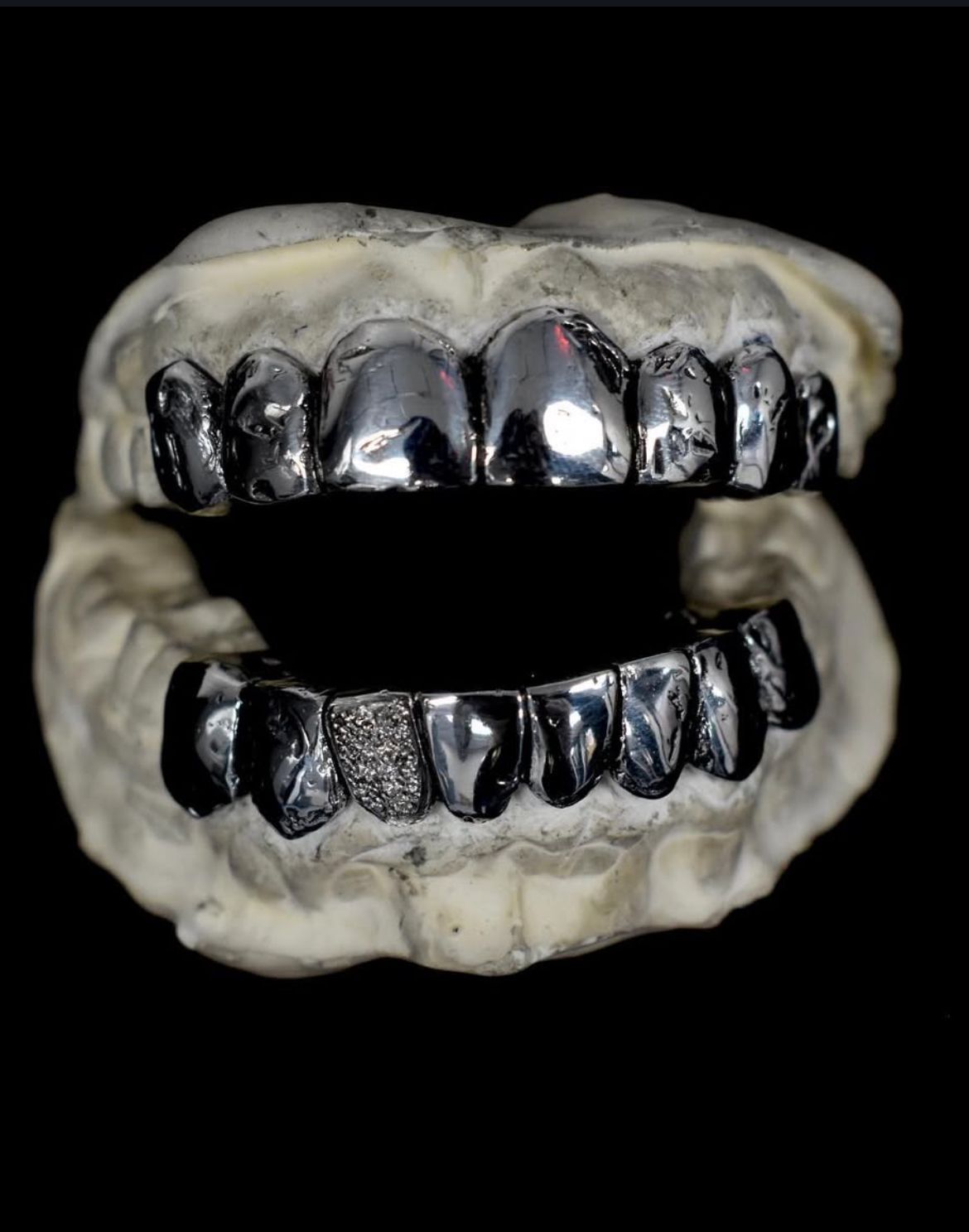
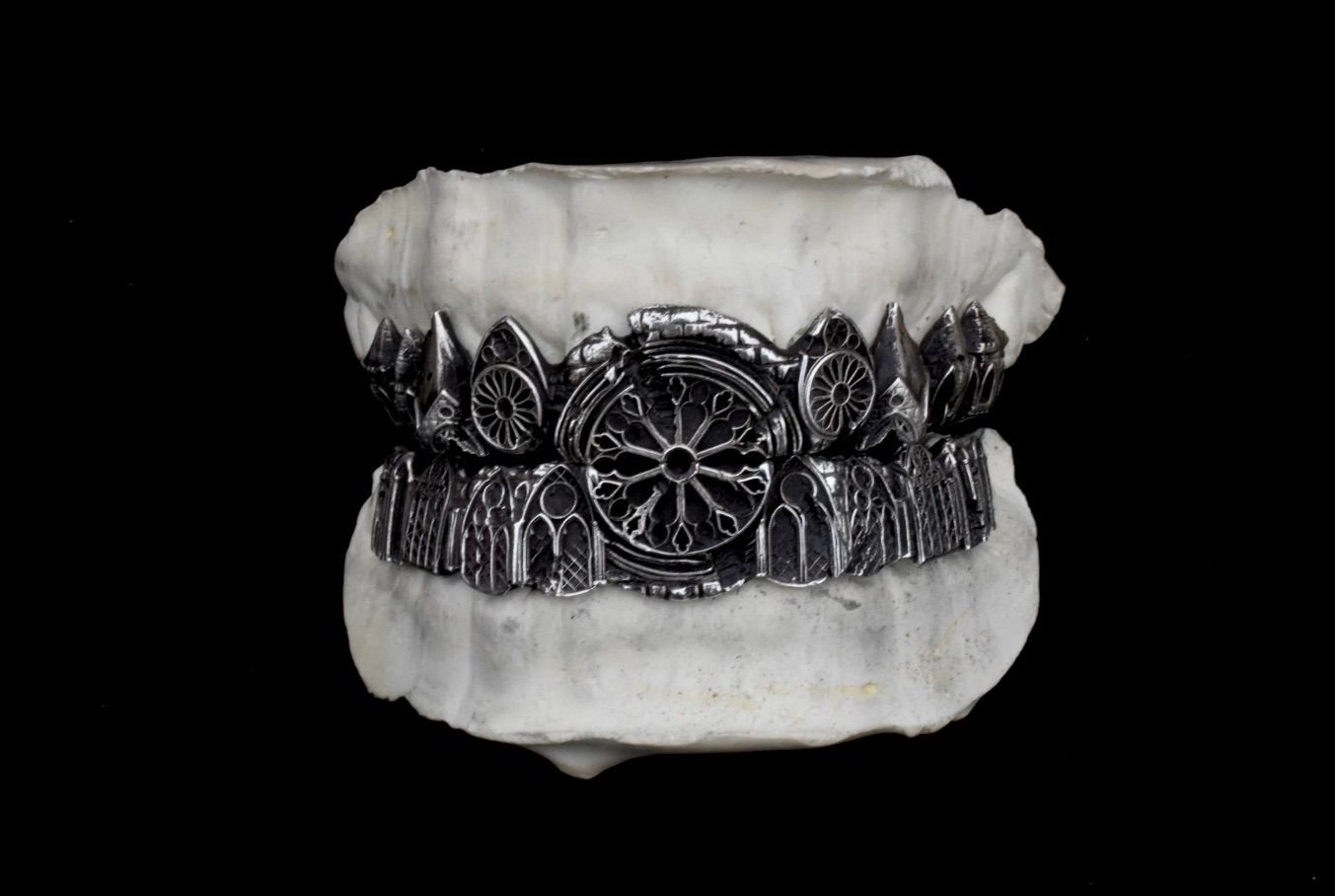
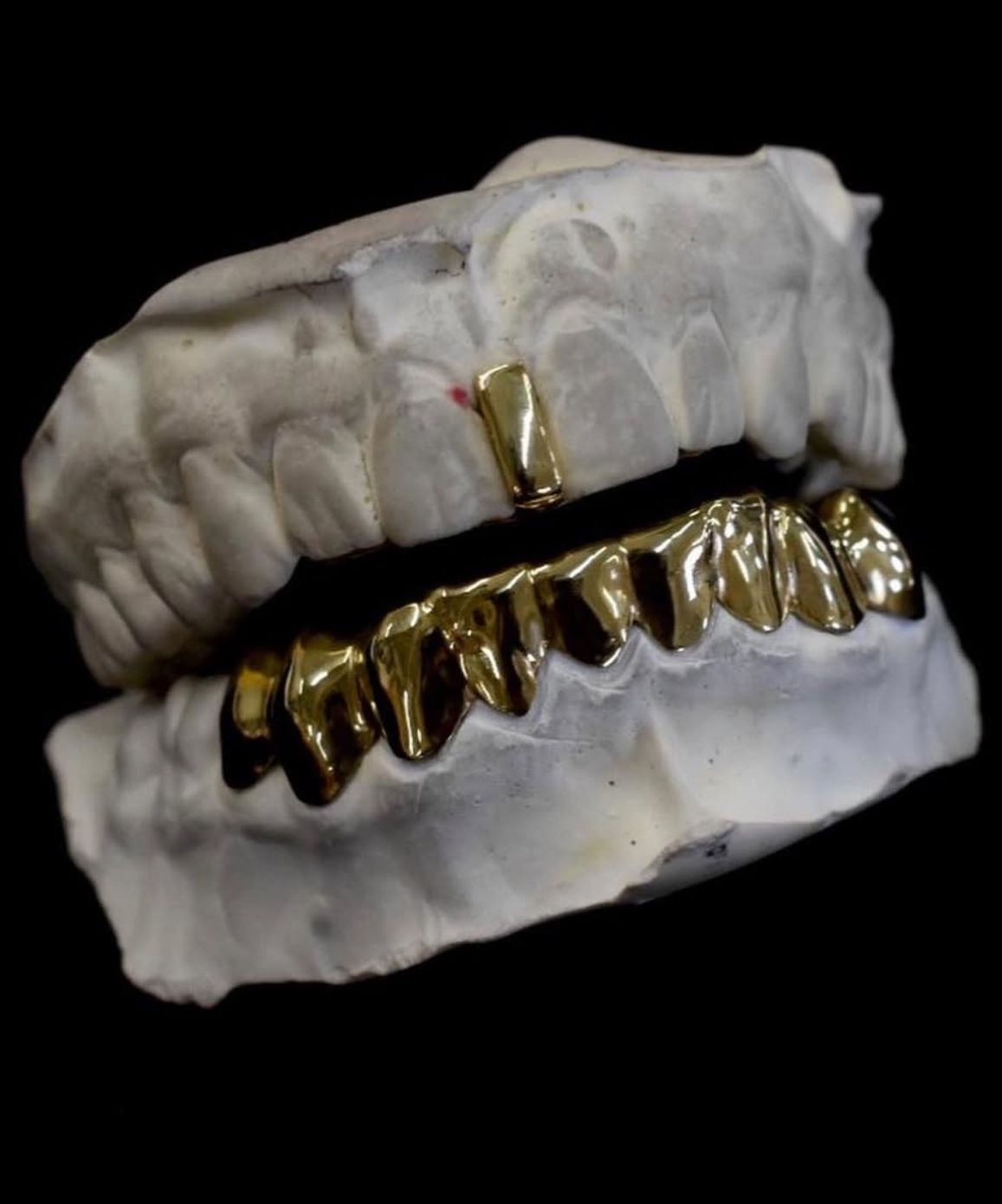
Left: 925, VVS1 Diamonds. Deep cut and decayed — newly titled Ogun’s set (2 of 2), made specially for Erika Badu, by Masahiro LaMarsh
Middle: Cathedral Set
Right: 24 Karat Grillz set for Landon Metz, by Masahiro LaMarsh
For New York-based grillz artist and sculptor Masahiro LaMarsh, metal isn’t just material—it’s a vessel for memory, identity, and history. Blending cultural heritage with human emotion, LaMarsh approaches metalwork and wearable art as deeply personal acts. Working within a growing grillz subculture shaped by Black American expression, his pieces turn craft into storytelling. From custom pieces for Shigeto, Kendrick Lamar, and Erykah Badu to marble sculpting in Carrara, LaMarsh continues to explore how art lives on the body.
In conversation with Stefania Basano for 032c, he reflects on identity, control, and why art should help us feel more human.
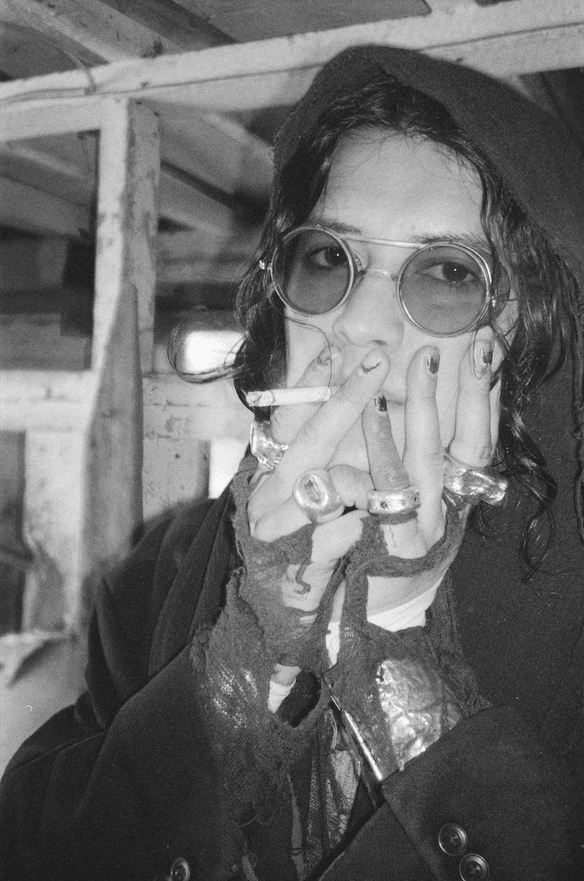
Masahiro LaMarsh, Photo: Kieva Campbell
Stefania Basano: What pulled you towards metal as a medium?
Masahiro LaMarsh: Metal just always had a certain lure for me. The objects can exist longer than our own individual lives, so I find that quite wonderful. I used to work in fashion and I just didn't find that permanence quite as rewarding as working with metal, there's just something alchemical and spiritual about it.
SB: Where do you usually start when you make custom pieces? And how much does it evolve along the way?
ML: When someone approaches me for a custom piece, a lot of my job is actually consulting. That’s because it’s your duty as an artist to work with them. I would say that a huge part of my process is identifying who they are as individuals and then how we can create something that is a reflection of who they are. That’s why metal is really wonderful—you’re able to capture people’s personalities in the pieces made.
SB: So, you would say it’s more of a collaborative project.
ML: It is collaborative, but what they’re bringing to the table is themselves, and that’s all I need. My job is to come up with an idea for them—they’re looking for me for that answer.
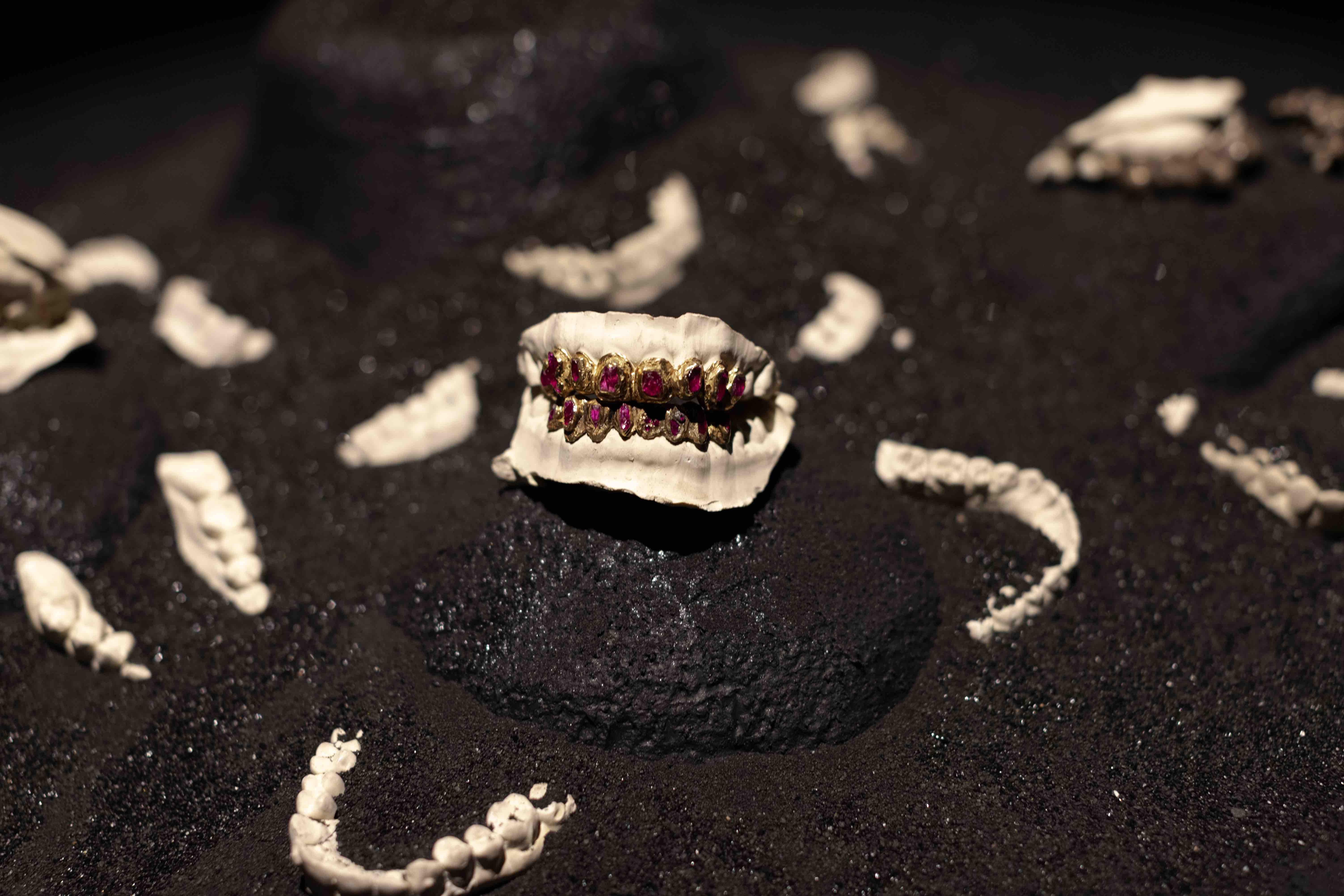
Red Ruby Prototype for Badu, Photo: Alexandra Husley at Dallas Contemporary
SB: Your exhibition is called “Anticlastic,” the term is sculptural and evokes movement and tension. How does that energy shape the exhibition?
ML: First, we’d have to understand the definition of anticlastic. It’s a term you learn when you’re smithing. There are different types of clastic curves, and an anticlastic curve is one where—if you think of a bagel—it’s the inner “C” shape that wraps from the inside. A perfectly formed anticlastic curve would wrap all the way around the ring, but it’s shaped outward, with the “C” facing toward you.
I chose that term for the show because there’s no true center point in an anticlastic curve. You can mark a center, but there’s no actual object there. And when I think about myself as a creator, most of these pieces are reflections of collaborations or journeys I’ve taken with others. So, if I exist in the center, but there is no center, what we’re left with is a form that exists on the outside, facing outward toward others.
The shape becomes a testament to the importance other people have had in my life. I want to shine the light on them more than on myself. It just so happens that I’m the singular thing bringing everyone together.
SB: That ties into the concept of wabi-sabi—letting imperfections and traces of human touch stay visible in your pieces. How do you decide when a piece is done?
ML: If there’s an objective goal—for example, I know that it needs to look a certain way—then I’ll work on it until it looks exactly the way I had planned. The thing is, whenever you create something and there is space for the wabi sabi mentality, you don’t really have to revise it too much. There’s so much honesty in mistakes. I’ve always hated jewelry that was perfect. And with objects in general, it’s really hard to go for perfection and do it well. I think it’s better to let things be imperfect. That’s what makes it very human.
With certain pieces, you have to be okay with moving on. That includes finishing a piece and accepting it even when a mistake has been made. You know it’s done when the feeling is there, and the piece feels finished.
SB: It’s kind of like writing. I can revise it as many times as I want, but when it’s done, it’s done.
ML: Yeah, it’s about acknowledging that you tried your best.
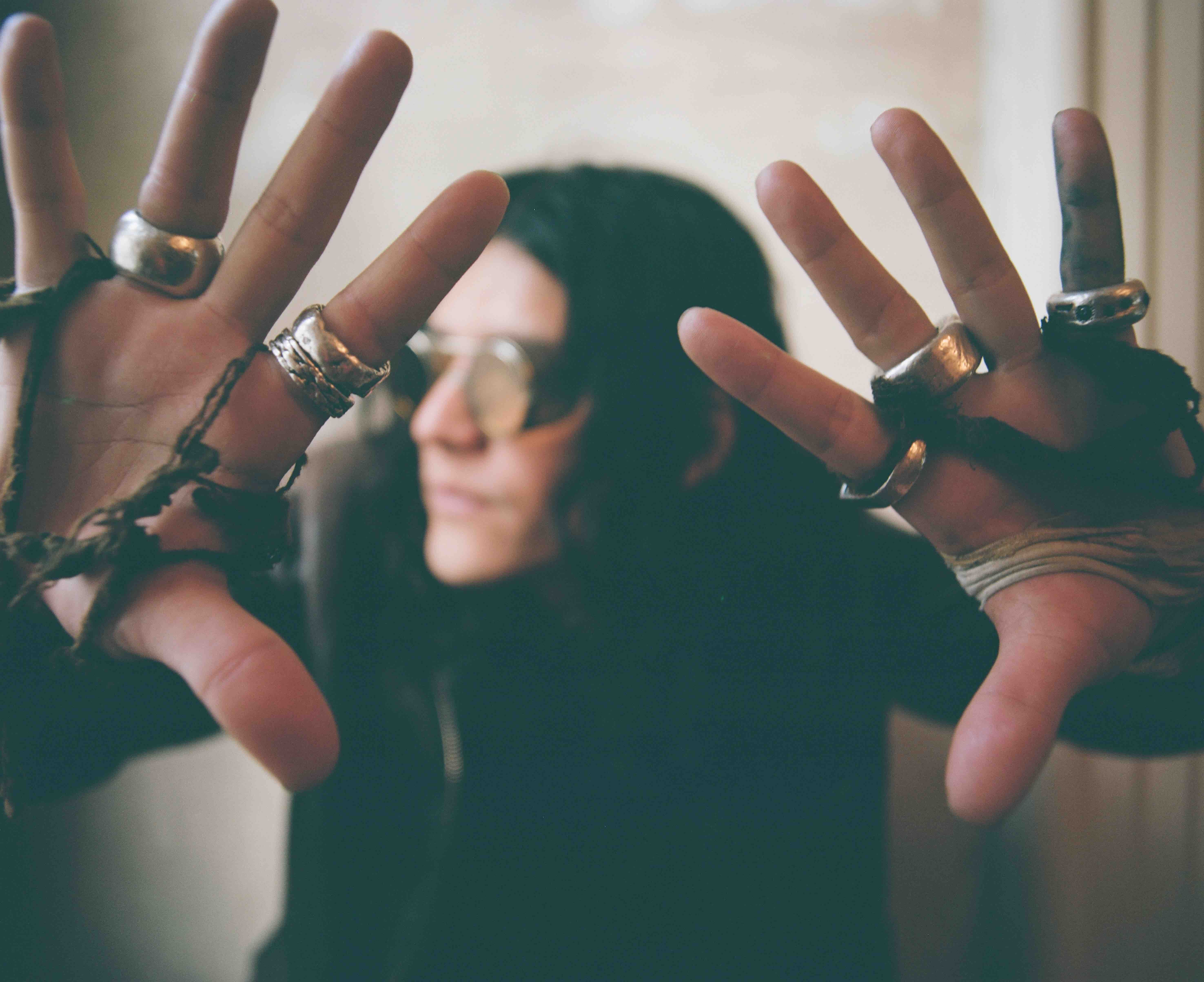
Masahiro LaMarsh, Photo: Kieva Campbell
SB: Along with shaping metal by hand, you also studied marble carving in Carrara. Both require a lot of patience and precision. What have those processes revealed to you about control and about letting go?
ML: Marble sculpting is beautiful. It means so much to me personally, for my own identity. When I was in Italy, I didn’t come back as the same person—my life was forever changed from that experience. And if I could be 100 percent honest with you, I find a lot of power in marble sculpting. It also evokes something in the inner child—a little bit of rage, a little bit of desire to destroy—then doing it in a way that is so delicate and with so much love.
The way you’re caressing a tool that is cracked out like a handheld jackhammer, and the way that you have to sew the pieces to get the tenderness of yourself—there’s something beautiful and masculine about this.
But it’s a lot harder to be wabi sabi with marble sculpting because it’s a lot more intentional. I kind of leave things very rough, and then I’ll go in—I don’t start with too many expectations. Whenever people think of marble sculpting, they think you should have everything completely mapped out, and everything should be to the T.
I don’t do that. I just draft an idea, and then I start trying to slowly chase it. But it doesn’t have to be the exact idea, it just has to be the feeling. And my pieces are not literal pieces, you know? I think my pieces are more fluid and off the cuff than, say, model sculpting. That’s where I can balance perfection and imperfection. I can just acknowledge that I’m working on this thing, and I’ll know when it’s done. I don’t have expectations for myself to be perfect.
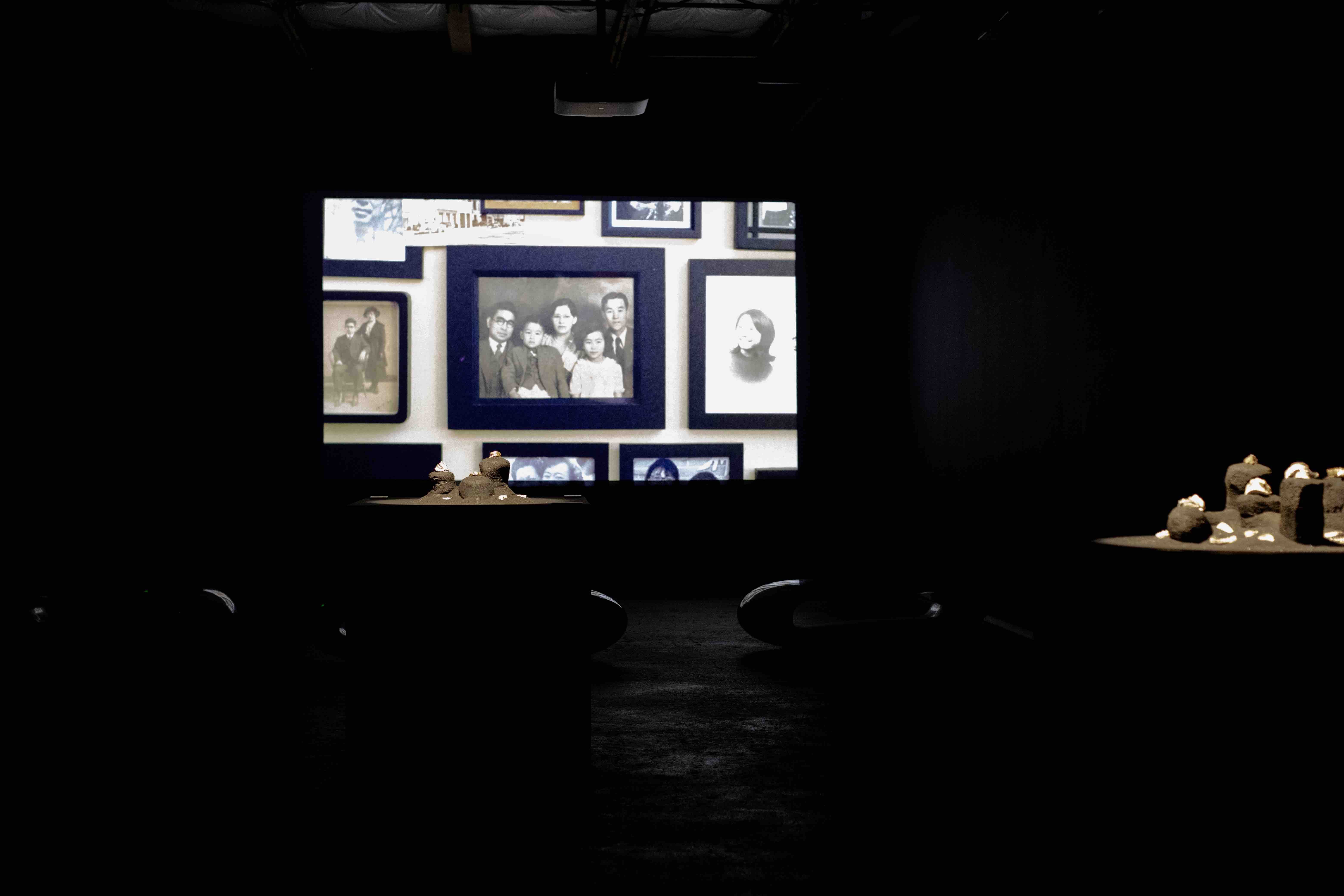
DENSHO Still, Photo: Alexandra Hulsey for Dallas Contemporary
SB: Your collaboration with Shigeto folds sound, memory, and family history into metal. How did his Japanese American heritage shape the material and your approach to this piece?
ML: I’ve known Shigeto for a long time. He used to be a client of mine, but now we’re like brothers. We share this very unique identity because we’re both Hapa—which, in Asian terms, means being half Asian, half white. So, the grill set that we made was part of a process of recognizing that we’re on a very unique trajectory. We were really lucky to intersect with each other in that way.
The set is a white gold piece with sapphires, and it’s an homage to cherry blossoms. We did that project years ago, and since then, Zach (Shigeto) has been leaning even more into exploring his Japanese heritage. He just released an album called Cherry Blossom Baby (2024). Over time, we’ve both felt less alone in this journey and I think we’ve become advocates for this kind of storytelling.
The video we made is really important to us. I've been itching to work in different mediums, so I thought it would be a great idea to collaborate with him on it and his family is much more connected to their heritage. His grandma is still alive at 102; she’s the nicest lady ever—she doesn’t look a day over 60—but she survived the imprisonment camp process.
What’s happening here in the United States is getting real scary, real fast. So, this documentary is to encourage people to be better humans and see that history is repeating itself—we’ve already gone through this process. A week after we finished the video, the same law that enabled the imprisonment camps was reenacted. It hadn’t been touched until Trump reopened it. So, the project ended up being incredibly relevant.
We’re very happy that the piece is more educational than anything else. That’s why it feels so important to trace our roots and speak to the Japanese American experience. It gives Zach and me something real to talk about. As artists, it’s our duty to stand up for what is right. I am insanely grateful to the people who helped me on this journey, because we did this all out of pocket. We flew to Detroit and shot everything in five days. It was hell but we did it. And we all had our hearts in the right place, you know?
SB: Absolutely. And when you created the piece with and for Erykah Badu, you drew from her Moorish American heritage and spirituality. How did those conversations shape the design and feel of the piece?
ML: You’d have to understand, first, who Badu is as a person, and second, what my relationship to her is. Basically, everything you’ve heard about her being like a spiritual mother is true. She’s one of the most incredible people I’ve ever had the opportunity to work with. That can go down on paper, that can get tattooed.
That piece got made because I had this experimental set I’d created that looked like a church. It came out of my time in Italy, where I got really into Catholic architecture. After I worked with Badu on a smaller piece, she asked what else I had. I showed her the Catholic-inspired set, and she was blown away. She absolutely loved it.
Then she encouraged me. She said, “All right, now I want you to look up Moorish architecture and Islamic and Arabic heritage.” She essentially challenged me. I’ve always loved a good challenge. For a couple of weeks, I went to the New York Public Library every day, digging through their special stacks and their super antiquated books, studying them.
I think a key thing to recognize here is that Badu challenged me, but she also blindly supported me. She was just like, “Whatever you come up with will be good. Just do what you can do.” And our friendship has really flourished since then. She’s the dream client, she’s become my spiritual mother.
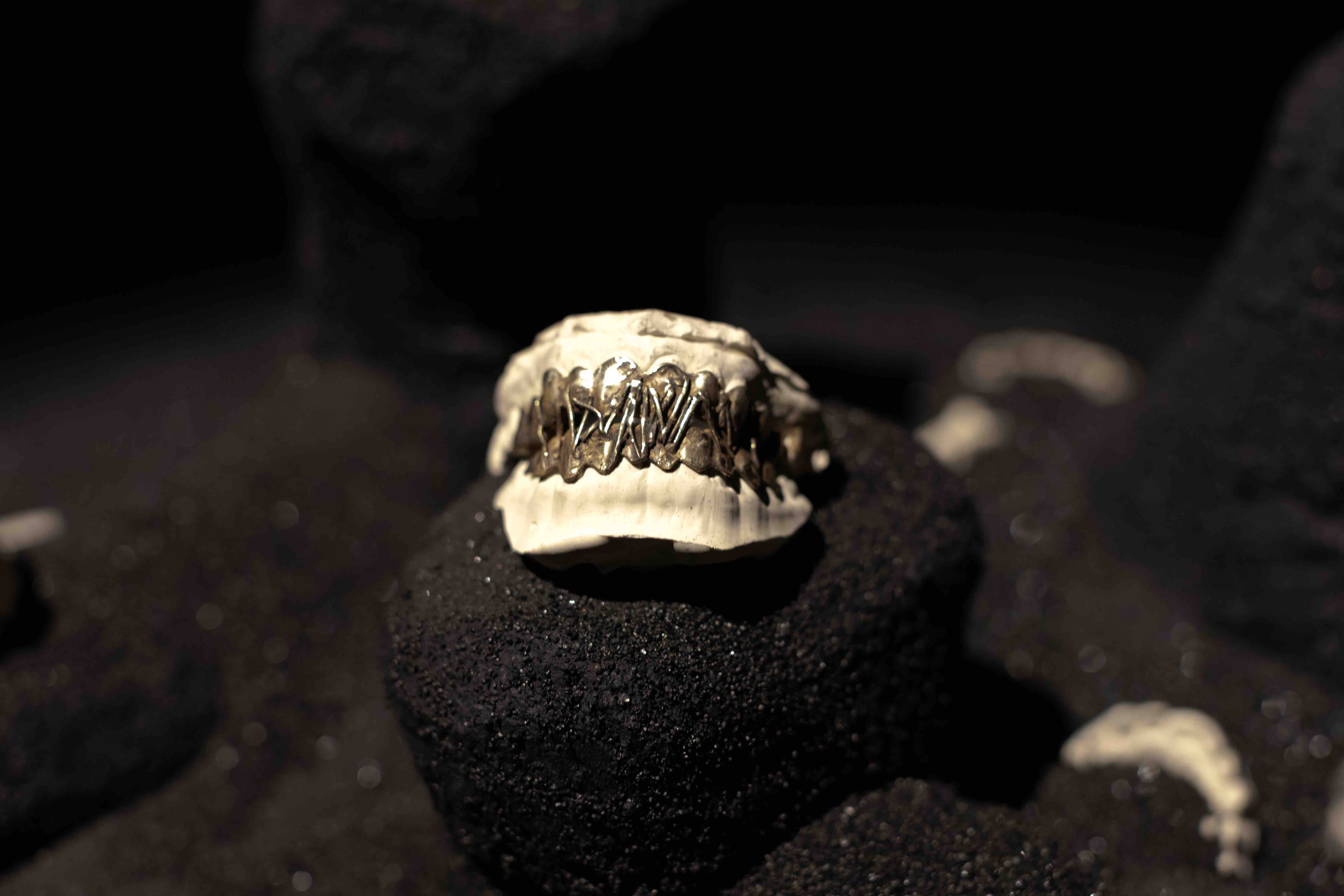
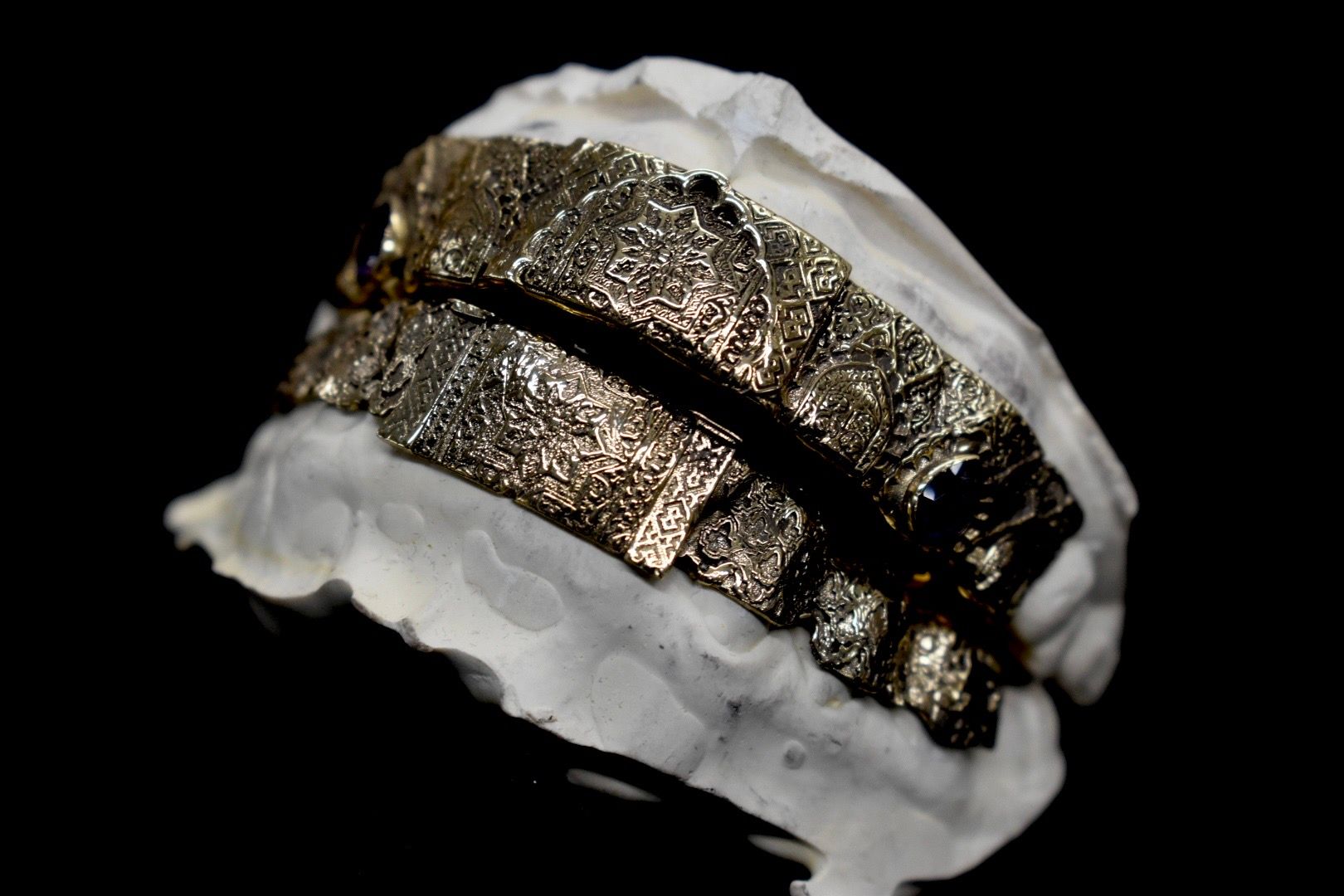
Left: Raw Bronze, untouched patine, Photo: Alexandra Hulsey for Dallas Contemporary
Right: Moorish set, made custom for Erykah Badu
SB: You’ve also created pieces for Kendrick Lamar’s tour as well as for some really big clients. How do you stay grounded in your own voice and vision when you’re collaborating at that level?
ML: For the Kendrick Lamar tour, it was a little bit more linear. They had a bunch of dancers, and I couldn’t tell if they wanted me to go off the cliff or be controlled in a way. So, ultimately, the grillz ended up being very simple for them.
But I think people can’t tell if they want to let me run away without a leash, or if they want me to stay at bay—especially when you’re talking about a lot of money moving, because you have to be responsible. If it’s too far gone, you feel like you wasted money. And if it’s not enough, you feel like you’ve wasted money. It’s a very delicate thing to balance.
But honestly, what I’ve realized with higher-end clients is that you’re usually safe to be a freak bitch. The more freaky and honest you are as an artist, the better your seat in the room is. You don’t want to be at the end of a long rectangular table while they’re sitting at the head.
The best relationships are when you bring enough artistry to work with other artists, and suddenly the table is round and everyone has a seat, sitting together. You just have to be the king of your own kingdom, and then you get a seat at the round table.
SB: In those cases, it’s always good to carry yourself with confidence in yourself and in your work.
ML: Absolutely, and you realize that it is a collaboration, and that means that you are equally as important.
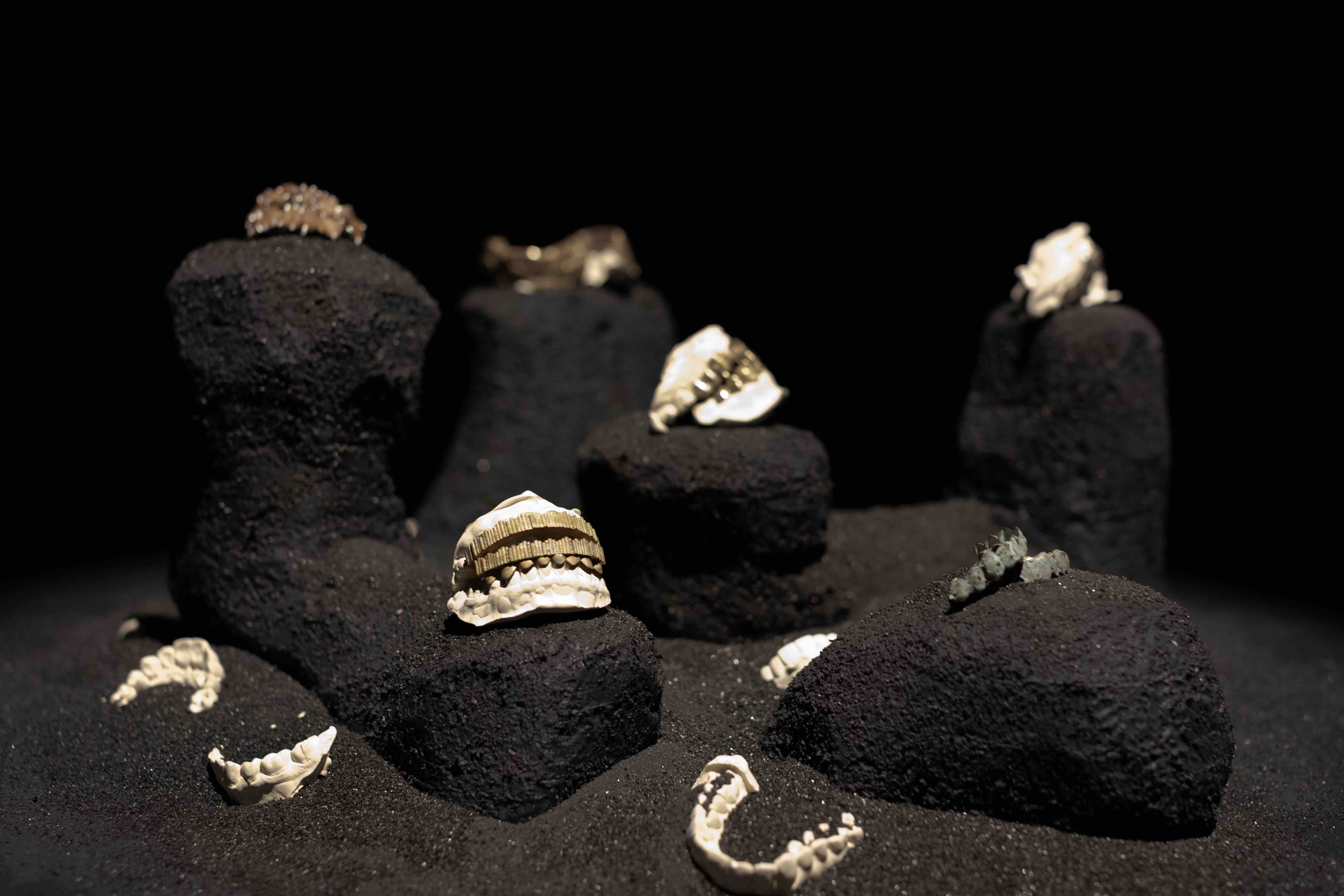
Plinth 2, Photo: Alexandra Hulsey for Dallas Contemporary
SB: Where do you see the future of wearable art heading? How do grillz continue to push boundaries and what the body can express and carry?
ML: I had this video that went viral a long time ago, and back then, people were like, “what the hell is this guy doing? That’s not a real job.” But being involved in the New York scene, I’ve seen so many grillz artists popping up every day. I’m seeing guys in Korea doing it, and I was even invited into this Instagram group chat for grillz makers. People are really running with the idea, and they’re creating work that I couldn’t even make. I’m like, damn, this stuff looks insane.
And with the grillz subculture, we have to give credit to Black American culture as well as the subculture that is getting spotlighted and is growing and progressing into an incredible art form. It’s so wonderful to see everyone doing their best and putting a soul into it.
I don’t think it will fade out, per se. We’ve done our job; it’s finally being recognized as a piece of jewelry—something that can exist. And it’s become more normalized. They’re like rings, they’re part of jewelry and personal expression now.
But my relationship with it is a little bit more complicated, I would say.
SB: How so?
ML: I quite like making grillz, and it was the thing that carried me for so many years in New York City. I built my reputation here locally on that. But I think I’m going to start positioning it as more of a creative outlet and focus on more extraordinary jobs; as an artist, rather than just as a jeweler.
I have to start investigating other routes in my life. One of them is working with larger sculptural objects. That’s where I want to push myself. I feel like I’ve earned that relationship with art. I’ve already done the best I could with the means I had, and now I want to push that envelope further for myself. Which might mean that I have to take a little bit of time away from grillz.
Something I’d love to promote, and that I’m working on, is setting myself up for a proper label—releasing jewelry and making my work a bit more accessible.
SB: When someone walks through the exhibition what do you hope stays with them?
ML: It would mean a lot to me if people can just walk out feeling more human. I want them to see a little bit of humanity and beauty. Right now, the arts are kind of struggling in the United States. But art is real, it’s something that is very needed. I want them to leave feeling inspired, and inspired to be a better human.
SB: That’s amazing. A bit of a fun one to end: if you could collaborate with anyone, no limits, who would it be?
ML: Well, my favorite artist is Louise Bourgeois. I think she could have been my mom or a cool aunt in a weird way. I would want to be in a room with her, crack jokes and make something that’s really ridiculous. I would have loved to work with her—or for her.
Masahiro LaMarsh’s exhibition Anticlastic is on view from June 21 to August 31 at Dallas Contemporary in Dallas, Texas. Tuesday to Saturday, 11AM to 6PM, and Sunday, 12PM to 5PM.
Credits
- Text: Stefania Basano